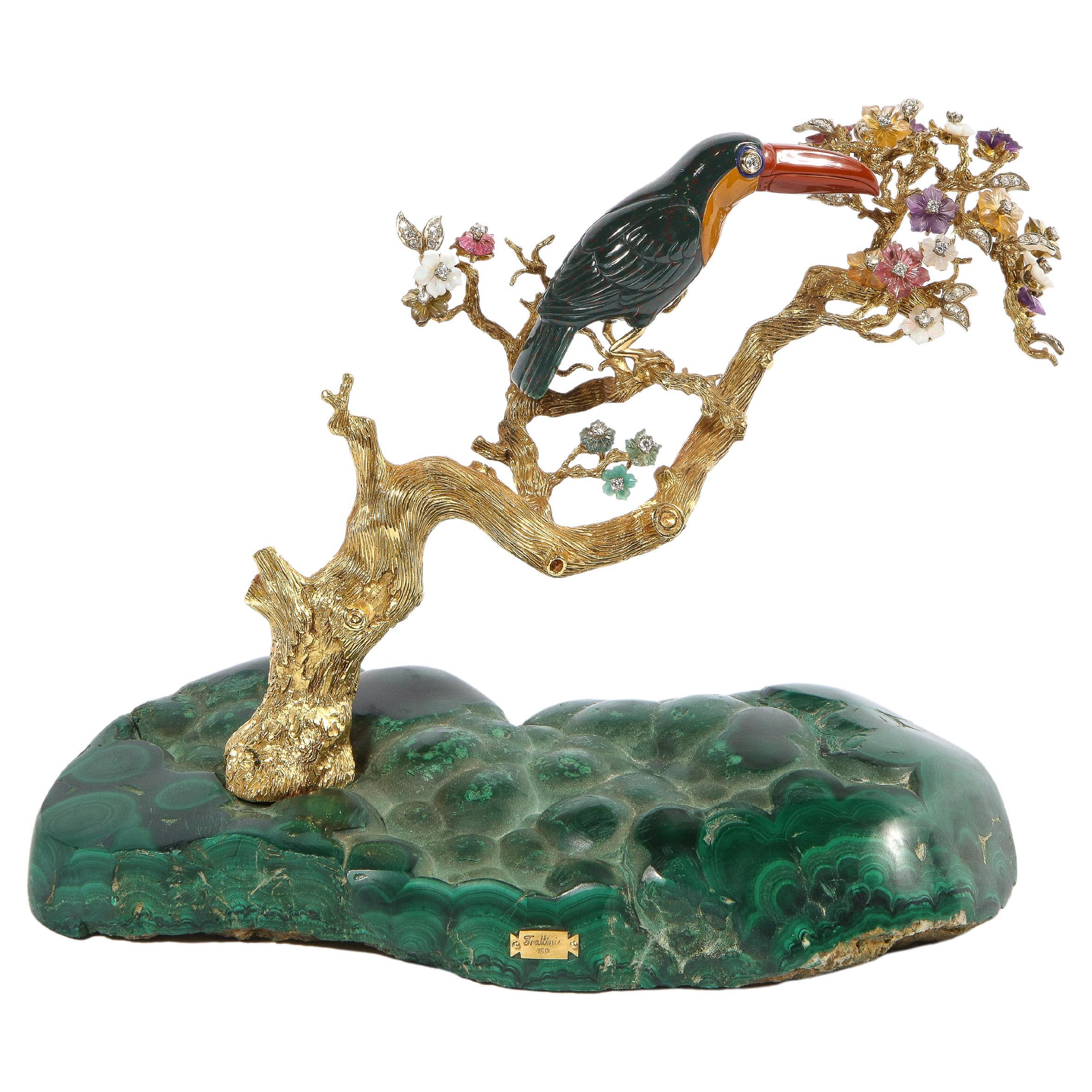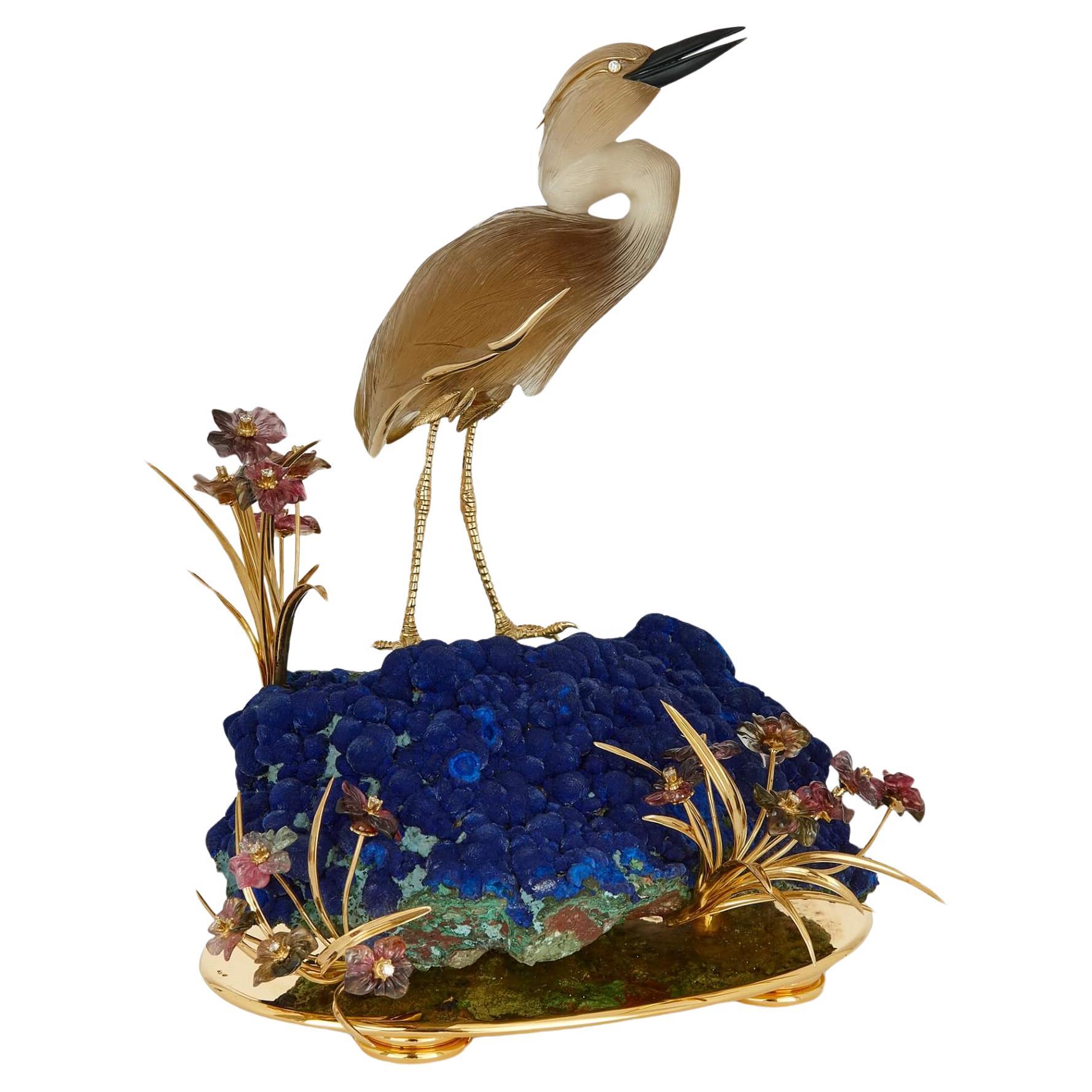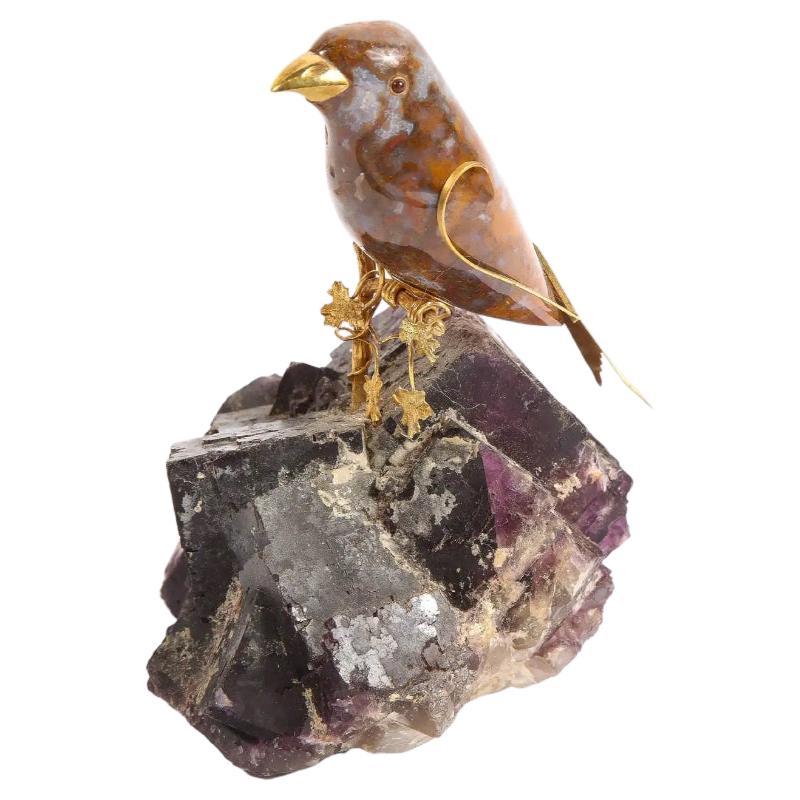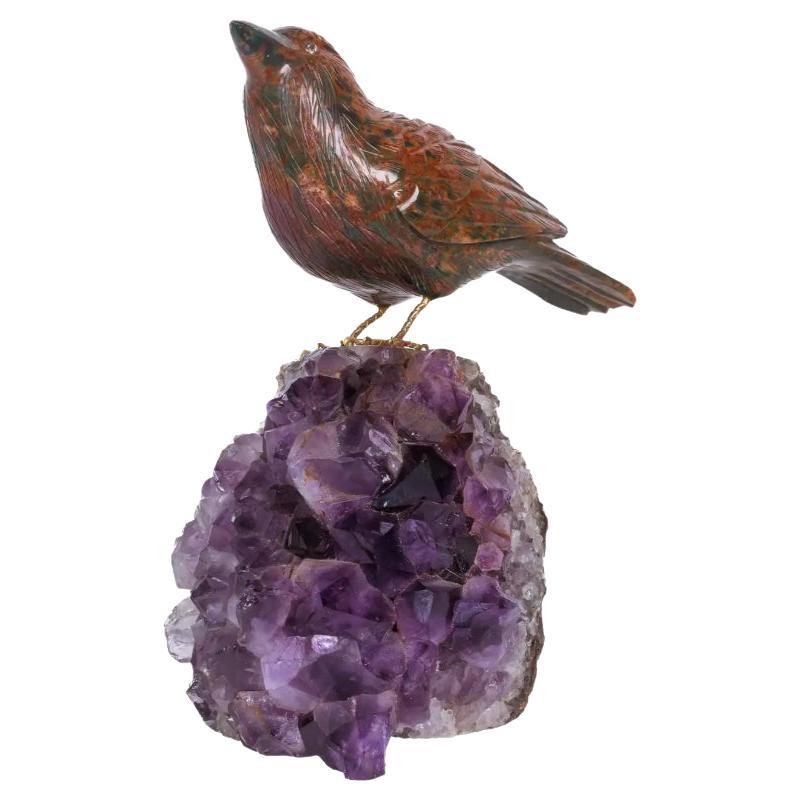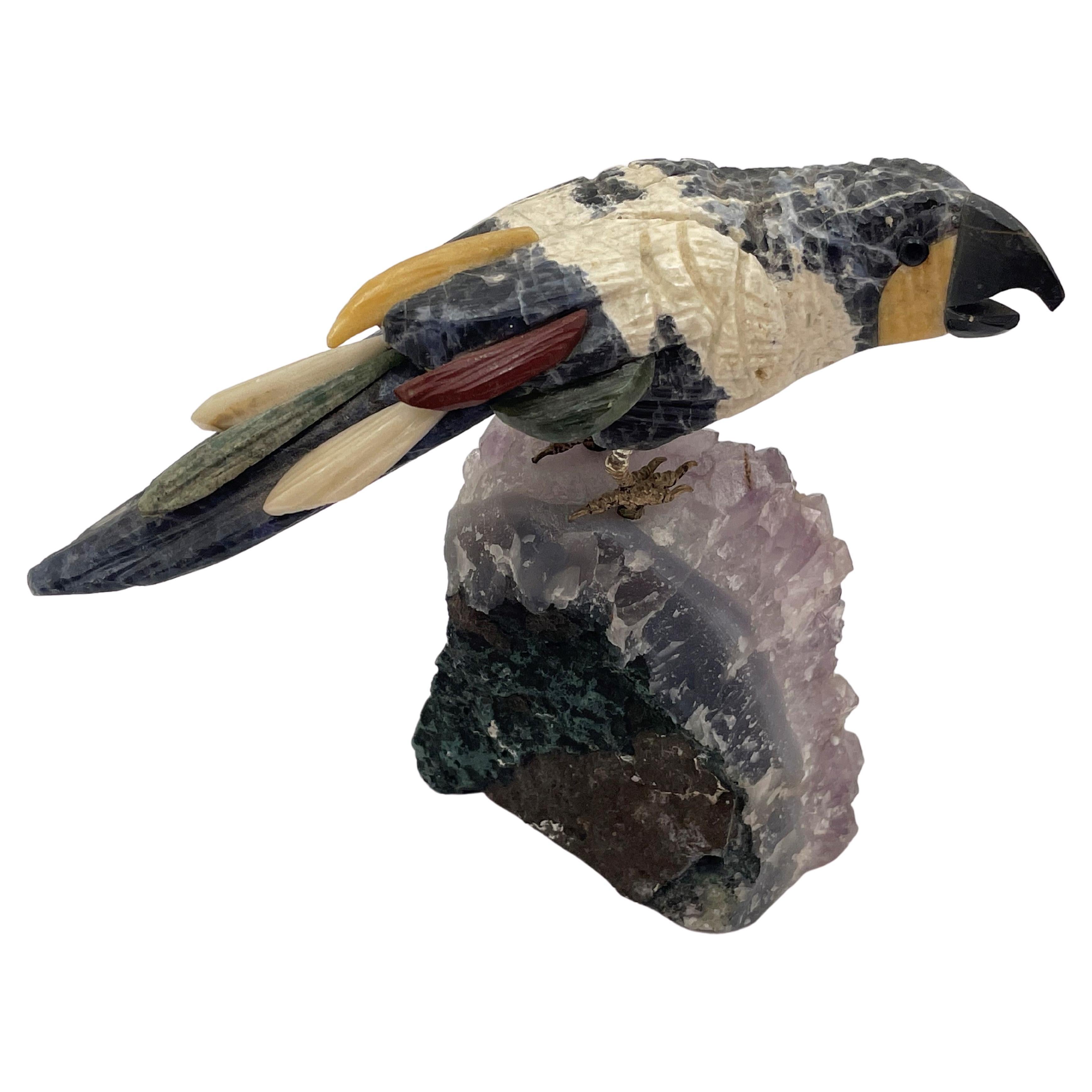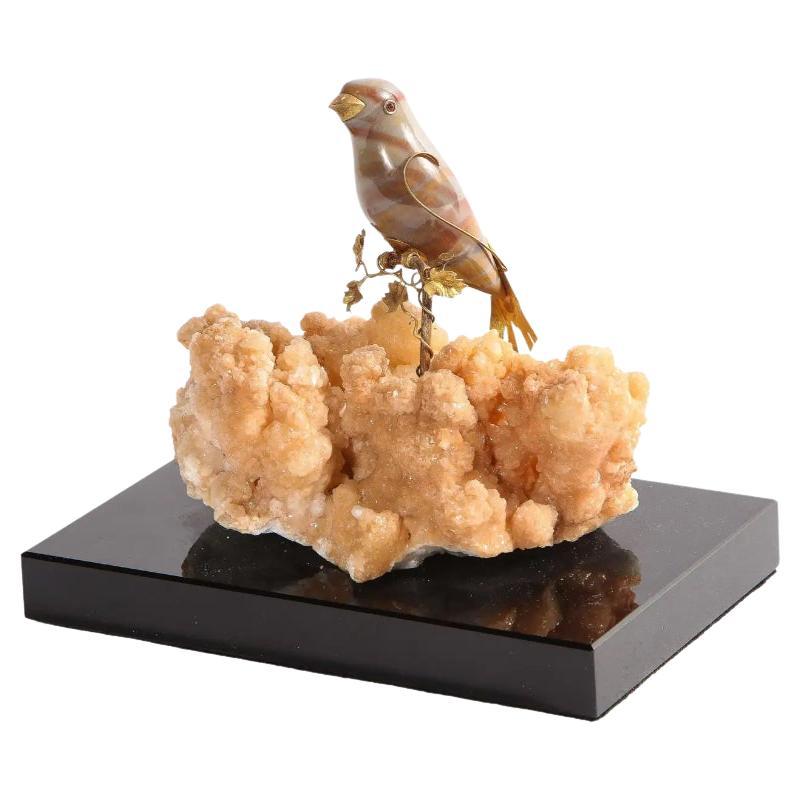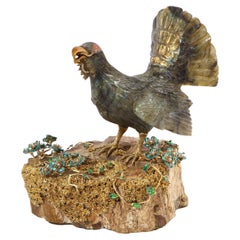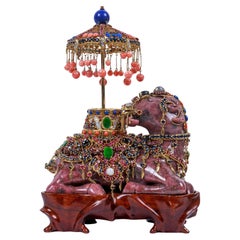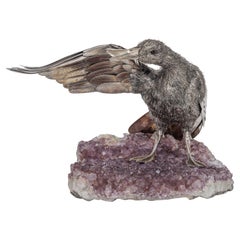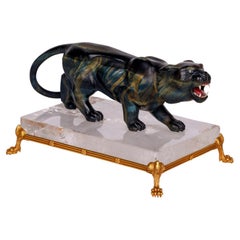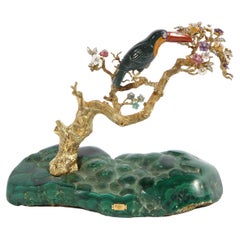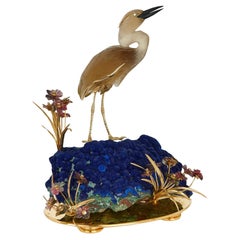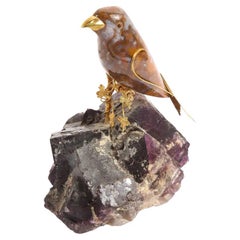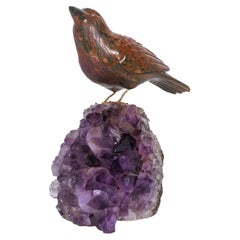Items Similar to 18K Gold, Diamonds, Amethyst, Tourmaline, Bloodstone, and Jasper Toucan Bird
Video Loading
Want more images or videos?
Request additional images or videos from the seller
1 of 13
18K Gold, Diamonds, Amethyst, Tourmaline, Bloodstone, and Jasper Toucan Bird
$38,000
£28,677.56
€32,831.46
CA$53,592.60
A$58,837.99
CHF 30,695.90
MX$712,021.59
NOK 384,725.52
SEK 362,512.59
DKK 245,078.12
About the Item
An 18K gold, diamonds, amethyst, tourmaline, bloodstone, carved emerald, opal and jasper toucan bird resting on a gold tree branch, mounted on a carved malachite base.
A very rare and unique gold-mounted jeweled object - a true collectors piece.
Italian, 20th century.
Signed Frattini and 750 to base.
Measures: 6" high x 6.5" wide x 4" deep
Very good condition.
- Dimensions:Height: 6 in (15.24 cm)Width: 6.5 in (16.51 cm)Depth: 4 in (10.16 cm)
- Materials and Techniques:
- Place of Origin:
- Period:
- Date of Manufacture:20th Century
- Condition:
- Seller Location:Queens, NY
- Reference Number:1stDibs: LU1798227704652
About the Seller
5.0
Vetted Professional Seller
Every seller passes strict standards for authenticity and reliability
Established in 1980
1stDibs seller since 2016
63 sales on 1stDibs
Typical response time: <1 hour
- ShippingRetrieving quote...Shipping from: Queens, NY
- Return Policy
Authenticity Guarantee
In the unlikely event there’s an issue with an item’s authenticity, contact us within 1 year for a full refund. DetailsMoney-Back Guarantee
If your item is not as described, is damaged in transit, or does not arrive, contact us within 7 days for a full refund. Details24-Hour Cancellation
You have a 24-hour grace period in which to reconsider your purchase, with no questions asked.Vetted Professional Sellers
Our world-class sellers must adhere to strict standards for service and quality, maintaining the integrity of our listings.Price-Match Guarantee
If you find that a seller listed the same item for a lower price elsewhere, we’ll match it.Trusted Global Delivery
Our best-in-class carrier network provides specialized shipping options worldwide, including custom delivery.More From This Seller
View AllRare 18K Gold, Enamel and Diamond Mounted Carved Labradorite Turkey Bird
By Manfred Wild
Located in Queens, NY
A rare 18K gold, enamel and diamond mounted carved labradorite turkey / Capercaillie bird sculpture on a petrified wood base, attributed to Manfred Wild, Idar-Oberstein, Germany.
Very finely crafted of the highest quality and best color Madagascar labradorite with excellent labradorescence. The entire hand carved turkey displays and excellent shimmer effect known as labradorescence.
Madagascar labradorite, rich in the phenomenal characteristics of this remarkable gemstone which displays an ever-changing sheen, that is extremely suitable for the rendering of this turkey bird...
Category
20th Century German Mounted Objects
Materials
Gold, Enamel
Exquisite 14K Gold, Diamonds, Emeralds, Rubies, Semi Precious Stone Camel
Located in Queens, NY
An Exquisite 14K Gold, Diamonds, Emeralds, Rubies, Sapphires, and Semi Precious Stone Mounted Rhodonite Camel.
Possibly by Verdura, circa 1970, Italy.
A very good quality and unusual gold mounted jeweled object...
Category
20th Century Italian Mounted Objects
Materials
Gold
An Elegant Mario Buccellati Sterling Silver Duck Perched on an Amethyst Base
By Mario Buccellati
Located in Queens, NY
An Elegant Mario Buccellati Sterling Silver Duck Perched on an Amethyst Base, Milan, 20th Century
This exquisite creation epitomizes the craftsmanship and luxury for which Mario Buc...
Category
20th Century Italian Animal Sculptures
Materials
Amethyst, Sterling Silver
Rare Carved Hawk's Eye Agate Tiger on a 14K Gold Mounted Rock Crystal Base
By Cartier
Located in Queens, NY
A rare carved Hawk's Eye agate tiger on a 14k gold mounted rock crystal base, circa 1960.
"A Jeweled Sculpture"
An incredible carved tiger made...
Category
20th Century German Animal Sculptures
Materials
Agate, Rock Crystal, Gold
Mellerio Paris, a Silver, Gold, Lapis Lazuli, Coral, and Hardstone Picture Frame
By Mellerio
Located in Queens, NY
Mellerio Paris, a large silver, gold, lapis lazuli, coral, and hardstone picture photo frame with two falcons.
France, circa 2000
The frame resting on a lapis lazuli base with squa...
Category
21st Century and Contemporary French Picture Frames
Materials
Coral, Lapis Lazuli, Silver
An Exquisite and Rare French Louis XVI Style Ormolu-Mounted Bloodstone Inkwell
Located in Queens, NY
An Exquisite and Rare French Louis XVI Style Ormolu-Mounted Bloodstone Inkwell, circa 1875.
A truly exceptional and jewel like quality inkwell encrier, made with the finest ormolu, mounted on bloodstone. A true collectors and one of a kind piece.
Revival of the ancient régime in the late 19th century was paramount to the French furniture and bronze casting firms of the Belle Epoque. Imitation in the highest regard and replication of those tastes and styles was prevalent throughout the Paris Faubourg, where the most talented bronziers and ébénistes established their workshops. The present inkwell encrier recalls the late 18th century's obsession with hardstones - a taste expounded above all by the duc d'Aumont and, subsequently Marie-Antoinette. Such hardstone-mounted pieces, reminiscent of Renaissance schatzkammer objects, enjoyed a revived popularity at the end of the 18th century through the impetus of both the marchands-mercier and, more importantly, the hôtel des Menus-Plaisirs, where the duc d'Aumont himself established a workshop in 1770 specializing in the cutting and polishing of precious hardstones.
This exceptional inkwell encrier, sumptuously-mounted with finely chased gilt-bronzes, incorporates a highly-prized material such as bloodstone.
Sometimes called the Sunstone, the meaning of Bloodstone comes entangled in fascinating history. The Ancient Greeks held the Bloodstone as a gem with glorious powers. They referred to it as Heliotrope, which directly translates to Sunstone. It was believed to have heavenly healing powers gifted by the gods and most certainly when it came to healing all things related to the blood. Even as we move forward into the Middle Ages, the Bloodstone takes another mystical story under its wing. It was believed to be formed from Christ's blood. It was said that during the Crucifixion, a few red spots of his blood dripped...
Category
Antique 19th Century French Napoleon III Inkwells
Materials
Bronze, Ormolu
You May Also Like
18K Gold, Diamonds, Amethyst, Tourmaline, Bloodstone, and Jasper Toucan Bird
By Gianfranco Frattini
Located in Long Island City, NY
An 18K gold, diamonds, amethyst, tourmaline, bloodstone, carved emerald, opal and jasper toucan bird resting on a gold tree branch, mounted on a carved malachite base.
A very rare and unique gold-mounted jeweled object...
Category
20th Century Italian Figurines and Sculptures
Materials
Amethyst, Diamond, Tourmaline, Jasper, 18k Gold
Large 18K Gold, Silver Gilt, Diamond and Hardstone Bird Model by Asprey
By Asprey International Limited
Located in London, GB
Large 18K gold, silver gilt, diamond and hardstone bird model by Asprey
English, c. 1980
Height 22cm, width 17cm, depth 15cm
Made in around 1980, by th...
Category
Late 20th Century English Modern Animal Sculptures
Materials
Stone, Gold, Vermeil
14k Gold Mounted Agate Bird on Carved Amethyst Rock
Located in Long Island City, NY
14k Gold Mounted Agate bird on carved amethyst rock, 20th Century
A really nice and cool object - a true collectors piece. Part of a group of five birds....
Category
Antique Late 19th Century Unknown Animal Sculptures
Materials
Agate, Gold
14K Gold, Carved Jasper Bird on an Amethyst Rock Geode
Located in Long Island City, NY
14K gold, carved jasper bird on an amethyst rock geode
Hand-carved jasper bird with diamond eyes and 14k gold feet, sitting on an amethyst geode.
A...
Category
Antique Late 19th Century Unknown Animal Sculptures
Materials
Amethyst, Gold
Multicolored Bird Carved Stone Sculpture on Amethyst
Located in New York, NY
Highly realistic and detailed sculpture of a multi-colored bird with gilt silver legs perched on an amethyst base. This beautiful piece measures 3 3/4'' in height by 5 3/8'' in depth...
Category
20th Century Sterling Silver
Materials
Stone, Amethyst, Silver, Sterling Silver
14K Gold Mounted Agate Bird on Selenium Stone, Mounted on Black Glass
Located in Long Island City, NY
A 14K gold mounted agate bird on Fluorite stone, Mounted on black glass, 20th century.
A really nice and cool object - a true collectors piece.
Measur...
Category
Antique Late 19th Century Unknown Animal Sculptures
Materials
Stone, Agate, Gold
$2,925 Sale Price
35% Off
More Ways To Browse
Carved Tourmaline
Vintage Birds On A Branch
Vintage Jasper Furniture
Carved Jasper
Toucan Sculpture
Bird Amethyst
Carved Bloodstone
Fragment On Stand
Hand Axe
Antique Carved Pearl Shell
Brass Sailboat Sculpture
African Iron Sculpture
Antique Ox Cart
Antique Wagon Wheel
Roman Bath
Sea Shell Mounted
Moyr Smith
Encaustic Medieval Tile
